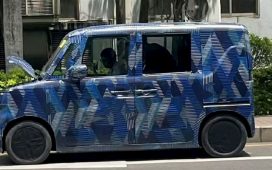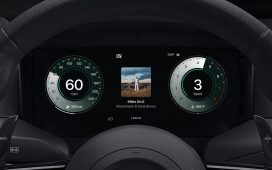On social media, supporters and critics have fought a fierce battle, driving the number of hits to dizzying heights. Business journals already singing farewell songs – hardly any new car caused as much of a stir in recent years as the Type 00, with which Jaguar is shaking off 100 years of history and reinventing itself as a luxury brand that is as electric as it is eccentric. And the highly polarising Hyper-GT is not even on the market yet.
Now, the British are showing that they can do things differently. When the same team launches the electric Range Rover at the turn of the year, after more than four years of development, there will be no experiments and certainly no shock waves, but tradition and perseverance: “First and foremost, we want to build the best Range Rover of all time,” said Head of Development Thomas Müller, “and only secondarily an electric car.” To ensure that nobody forgets the 55 years of off-road tradition, he proudly parked his prototypes between classic cars from the first four generations at the first meeting. So the new model should also offer what defines a Range Rover – cosy comfort, regardless of the surface.
Luxury values more important than electric car efficiency
More important to the British brand than electrical efficiency, in terms of the values that have made the Range Rover the ultimate luxury liner for the countryside, was the completely unagitated effortlessness and the superior vigour that can otherwise only be found in Rolls-Royce. The only difference is that this impression in the Range Rover must continue where the road ends.
Because in a Range Rover, you not only smoothly float along the road, but also drive effortlessly through mud and muddy conditions without the car showing any sign of its efforts, explained Müller.
On tarmac, the sheer and spontaneous power of the electric motors enables it to reach ghostly top speeds that should be well beyond 200 kph – but this has not yet been confirmed. Because it is also the most streamlined Range Rover of all time, thanks to a lot of fine-tuning and a fully panelled underbody, not even the slightest hiss or whistle penetrates the double-glazed windows.
Off-road, on the other hand, the computers race ahead and determine the correct power distribution in just a few milliseconds, finely regulate the explosive torque and thus guarantee that the Range never paws impatiently or starts to lurch, masters even icy inclines effortlessly and even masters one-pedal driving in deep snow if you don’t leave the work to the off-road autopilot for the adventure.
They gave more thought to thermal management than many other manufacturers, because the Range Rover is as much a permanent guest in the winter wonderland as it is in the desert. This is why the climate control centre constantly balances all interests and seeks the ideal compromise between battery conditioning and charging performance, interior comfort and range, and can recover energy from as low as -10 degrees with the heat pump.
The basis for this is provided by an electric architecture that was squeezed into a combustion engine platform, but in which the British brand nevertheless went big instead of small: two motors with 404 kW and 850 Nm make the electric Range this side of the old Range Rover SV with V8 petrol engine the biggest powerhouse in the family. An 800-volt battery with 117 kWh should enable a range of “well over 500 kilometres,” Müller promised. And charging takes place with 22 kW of alternating current and up to 350 kW of direct current, whereby, just like Porsche, they practise bank charging on a split battery and therefore want to be faster than the competition.
First and foremost, a Range Rover and only secondly an electric car – but this also has its disadvantages. This is because the architecture for all drive systems, from diesel to petrol and PHEV to BEV, requires a few compromises even at this level. The one-pedal driving so popular with Generation E is possible at the touch of a button. But they lack the space under the bonnet for a frunk. The huge boot is little consolation: Firstly, if you want to access the charging cable underneath, you have to lug a lot of suitcases out of a large space. Secondly, nobody wants to cram a cable between customised leather luggage and deep carpets in such a classy car.
60,000 interested parties – but without obligation
It is difficult to make an impression with the electric Range Rover. After all, it’s not much more than the lack of tailpipes, the type plates and, of course, the electric licence plate that makes the difference to petrol and diesel cars. On the other hand, how much more of an impression can you make than with the automotive equivalent of Buckingham Palace?
There is obviously no lack of curiosity. After all, the British company already registered over 60,000 interested parties. But only without obligation and without a deposit. After all, there is still no price for the electric Range Rover nine months before its market launch. But this much is already clear: The pleasure will certainly not be cheap. If the plug-in hybrid is already listed at just under 150,000 euros, you can easily expect to pay 170,000 euros for the EV. But that doesn’t matter. Customers are clearly not put off by the high prices – on the contrary: on average, they pay more than 150,000 euros per car, and 70,000 times a year, the British are pleased to report. No other model in this price region achieves such sales figures, whether electrically powered or conventional.






